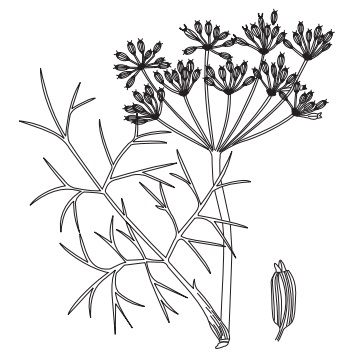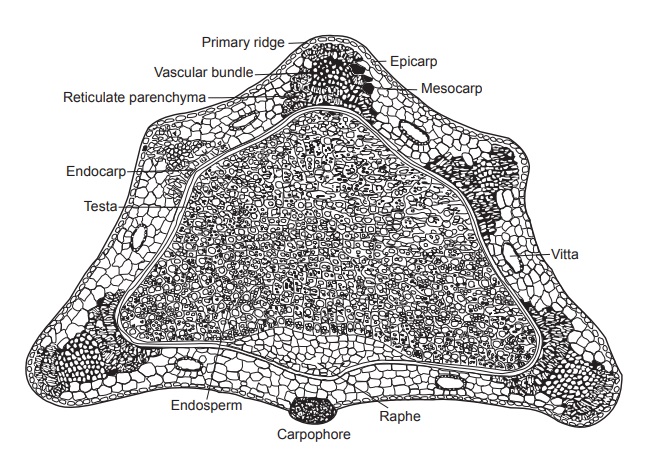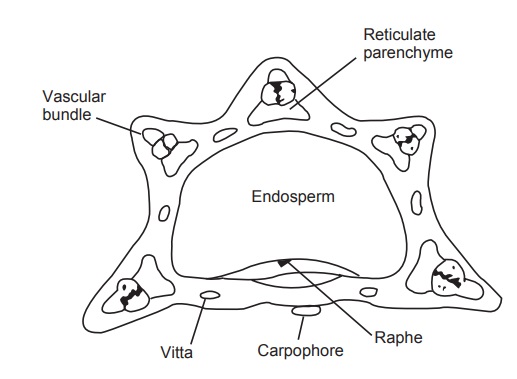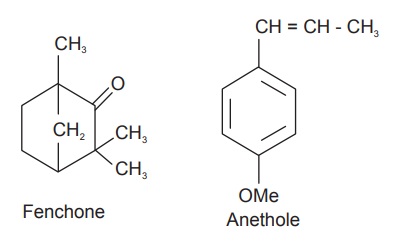Fennel
| Home | | Pharmacognosy |Chapter: Pharmacognosy and Phytochemistry : Drugs Containing Volatile Oils
Fennel consists of the dried ripe fruits of Foeniculum vulgare Miller., belonging to family Umbelliferae.
FENNEL
Synonyms
Fructus foeniculli, Fennel fruit, Fenkel, Florence fennel,
Sweet fennel, Wild fennel, Large fennel.
Biological Source
Fennel consists of the dried ripe fruits of Foeniculum vulgare Miller., belonging to
family Umbelliferae.
Geographical Source
Fennel is indigenous to Mediterranean countries and Asia; it
is largely cultivated in France, Saxony, Japan, Galicia, Russia, India, and
Persia.
History
Fennel was well-known to the Ancients, and it was also
cultivated by the ancient Romans for its aromatic fruits and edible shoots. It
is reported that during third-century B.C. Hippocrates prescribed fennel for
the treatment of infant colic, and later on after 400 years Dioscorides called
fennel as an appetite suppressant and recommended the seeds for nursing mothers
to increase milk secretion. Pliny suggested that fennel cured eye problems and
jaundice. Fennel seeds are commonly taken after meals to prevent gas and
stomach upset. The use of fennel shoots and seeds are mentioned in ancient
record of Spanish agriculture dating A.D. 961.
Cultivation and Collection
Fennel, a hardy, beautiful plant, perennial, umbelliferous
herb, with yellow flowers and feathery leaves, grows wild in many parts of the
world. Fennel is propagated by seeds during April in ordinary soil. Fennel
requires abundance sun light and is adapted to dry in sunny situations, it does
not call for heavily manured ground but it will yield more on well-drained
calcareous soil. About 4 1/2 to 5 lb of seed are sown per acre, either in
drills or 15 inches apart, evenly covered with soil. The plants grow to a
height of 2 m, erect and cylindrical and take enough space in branching. Most
of the branches bearing leaves cut into the very finest of segments. The plant
bears fruits in the second year and the bright golden flowers, flat terminal
umbels bloom in July and August. The fruits are collected by cutting the stems
in September, when the fruits are ripe. The stems are dried on sheaves under sun
and later beaten to separate the fruits.
Characteristics
The fruit is an entire cremocarps with pedicels, oval-oblong
and 5 to 10 mm long, 2 to 4 mm broad. It has greenish-brown to yellowish brown
colour with five prominent primary ridges and a bifid stylopod at the apex.

Microscopy
The transverse section of mericarp region of fennel shows
two prominent surfaces, the dorsal and the commissural surface. The commisural
surface has a carpophore and two vittae, and the dorsal surface has a total of
five ridges. The mericarp is divided into pericarp, consisting of the epicarp
and mesocarp; the testa and the endocarp. Epicarp consists of polygonal cells
of epidermis which are tangentially elon-gated and covered by the cuticle.
Mesocarp has parenchyma cells with five bicollateral vascular bundles; below
each primary ridge a lignified reticulate parenchyma surrounds the vascular
bundles. There are four vittae on dorsal surface and two vittae on commisural
or the ventral surface. Inner Epidermis or Endocarp shows parquetry arrangement
(a group of four to five cells arranged parallelly at acute angles with groups
of similar cells in different direction). Testa is a single-layered
tangentially elongated cell with yellowish colour. Endosperm consists of
thick-walled, wide polyhedral, colourless cells. Cells contain fixed oil,
aleurone grains, and rosette crystals of calcium oxalate.


Chemical Constituents
The best varieties of Fennel contain 4 to 5% of volatile
oil. The primary constituents of volatile oil are 50 to 60% of anethole, a
phenolic ester; and 18 to 22% of fenchone, a ketone. Fenchone is chemically a
bicyclic monoterpene which is a colourless liquid and the odour and taste is
pungent and camphoraceous. The oil of Fennel has β-pinene, anisic acid, phellandrine,
and anisic aldehyde. Fennel also contains about 20% fixed oil and 20% proteins.

Uses
Fennel is used as stomachic, aromatic, diuretic,
carminative, diaphoretic, as a digestive, pectoral, and flavouring agent.
Anethole may have estrogen-like activity and inhibit spasms in smooth muscles.
Fennel can increase production of bile, used in the treatment of infant colic,
to promote menstrua-tion in women, can increase lactation, act as antipyretic,
antimicrobial and antiinflammatory.
Adulterants
Fennel is generally adulterated with exhausted fennel and
due to improper caring during harvesting they are also adulterated with sand,
dirt, stem, weed seeds, etc in which part of volatile oil is removed either by
extraction with alcohol or steam distillation. Fruits exhausted by water or
steam are darker in colour, contain less essential oil and sink in water, but
those exhausted by alcohol still hold 1 to 2% of oil in them.
Marketed Products
It is one of the ingredients of the preparations known as
Abana, Shahicool, Anxocare (Himalaya Drug Company), Aptikid (Lubin Herbal
Laboratory), Jalifaladi bati (Baidyanath), and Hajmola, Janum Gunti (Dabur).
